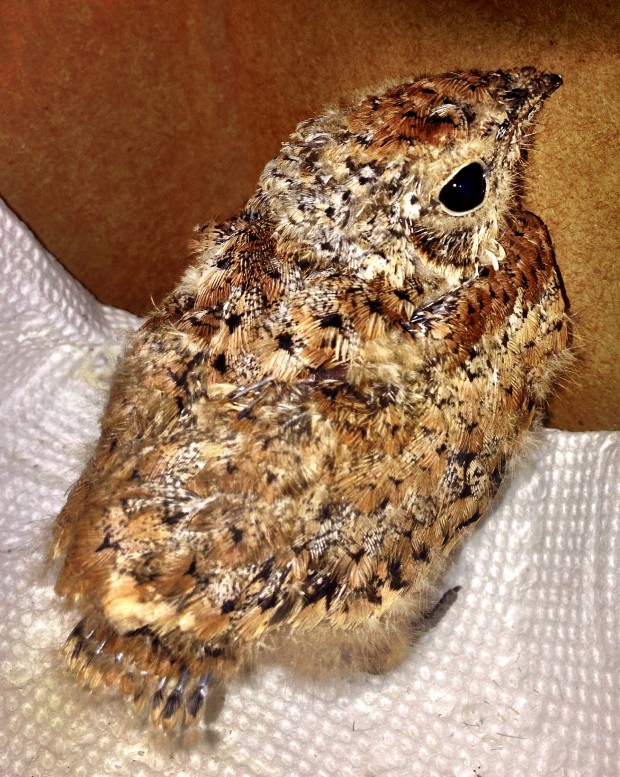
This baby Lesser Nighthawk had been separated from its parents and was running up the road on the Benson farm. It is now homed at the ARK in Port Aransas, Texas. Guy Davis Photo
“What is that?” we both said. We were coming back from closing the chicken pen. It was just after dark on a moonless July night. Something was running along the dirt road in front of us. It looked like a baby chicken.
In fact, it was a chick, but not a chicken’s chick. It was a baby Lesser Nighthawk. It still had its downy feathers. It couldn’t fly but it could run. The chick was moving along pretty fast. I had no idea that such a young nighthawk could run like that.
We didn’t see its parents anywhere. Perhaps it had run quite a ways from the nest. And it was exposed and vulnerable. It was looking a whole lot like a bobcat’s dinner (or more like an hors d’ouvre).
So, I had my husband catch it. It was fast, but Robert was faster. I had no idea my husband could run like that!
We put the small creature in a roomy cardboard box and closed down the lid. It was dark, safe and quiet in the box. The chick was calm, but it made tiny little nighthawk-like purrs and chirps.
We couldn’t keep the chick. We knew it was too young and would have to be fed. Besides, you are not supposed to have a wild bird in your possession without a permit. It would need regular feedings of insects, preferably large juicy ones. So we arranged for it to go to the ARK in Port Aransas. The ARK is an animal rehabilitation facility at the University of Texas Marine Science Institute. A young rehabber there has had great success caring for baby nighthawks and nightjars.
Of course, the rehabber who took the bird to the ARK, accused us of “kidnapping” the baby. That stung a bit, but I still believe we were “rescuing” it from predation. Maybe the parents were around, and maybe it would have made it on its own, but I doubt it. It was acting too much like an easy meal for a coyote, bobcat or even a housecat. I am glad we rescued it.
Lesser Nighthawks are summer residents in the south Texas brush country. They are found throughout the southwestern United States. In winter they migrate to Mexico and Central America. Nighthawks are members of the Caprimulgiformes, the “goatsucker” family of birds. All of the species in this family have small, soft bills but they can open their mouths very wide. Most of them are nocturnal hunters that catch large insects in mid-air.
Nighthawks nest on the ground, or sometimes on flat roofs. They are not great nest-builders though, preferring to simply use bare gravelly ground with no added material. The female lays two white eggs that are heavily speckled. She incubates the eggs for about 18 days. When the semi-precocial chicks hatch, their eyes are open and they can walk towards their parents soon after hatching. It is thought that they stay in the vicinity of the nest. Both parents feed the chicks by opening the chicks’ tiny bills slightly and regurgitating insects into their gaping mouths.
On this high-protein diet, the chicks grow fast. Soon they begin to grow feathers and can fly at three weeks. Like their parents they fly rather low to the ground and just above bushes to catch insects, mostly at night. Occasionally they will jump upward from the ground to catch low-flying prey.
The most striking features of Lesser Nighthawks are their vocalizations. The weird calls of these nighthawks never fail to impress listeners. In addition to a soft, repetitious “chuck”, they utter various toad-like calls. But it is the soft whinny, all on one pitch, that gives the bird its other common name, the Trilling Nighthawk. Unless you are told that these sounds come from a night bird, you might easily think they were made by an amphibian.
We heard from the ARK the next day. The chick had been fed fresh, juicy mealworms and had even gained weight overnight. In a couple of weeks, it should be ready to release back into the wild.
I want to release it back here where we found it. It was born here and its parents will be here until the end of summer. Maybe they can re-unite!
ESSAY BY KAREN L. P. BENSON
If you would like to receive Karen’s Nature Essays by email, please signup here.
